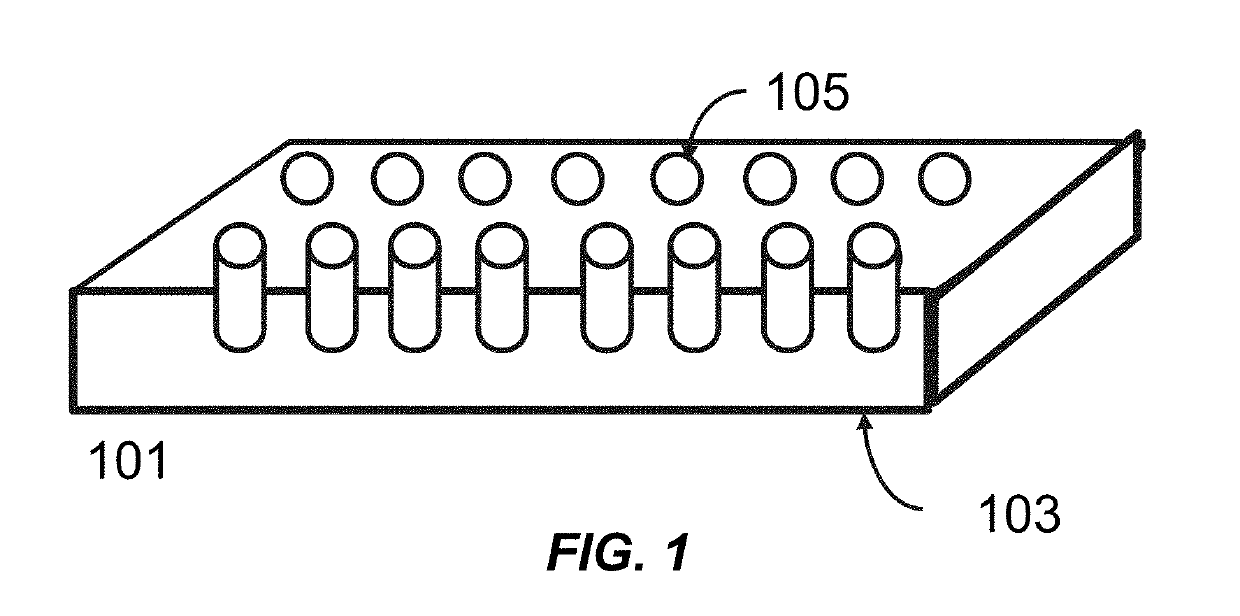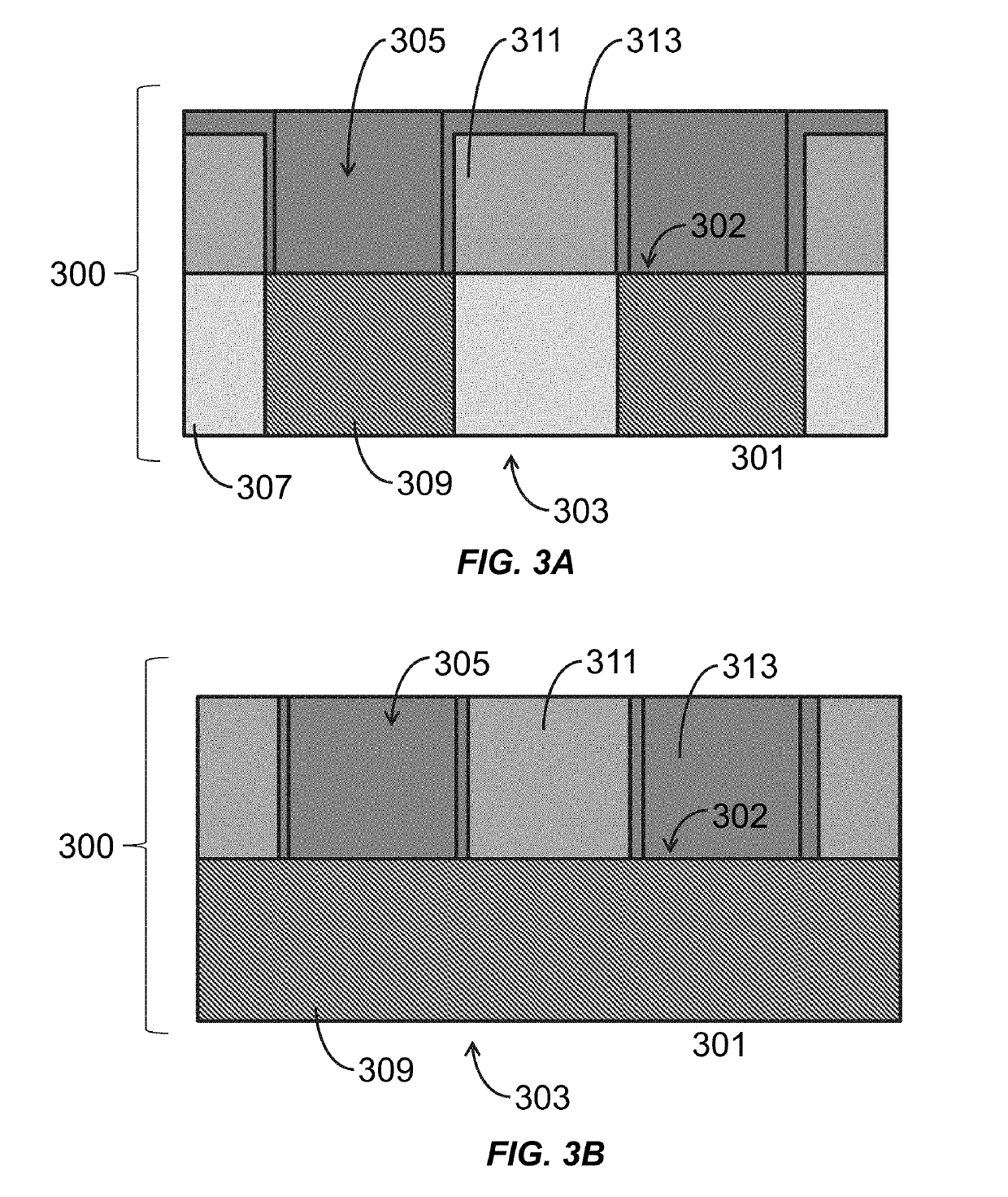Heated nanowells for polynucleotide synthesis
a nanowell and polynucleotide technology, applied in the direction of sequential/paralleled process reactions, chemical/physical/physical-chemical processes, chemistry apparatus and processes, etc., can solve the problems of high cost, high cost, predictability,
- Summary
- Abstract
- Description
- Claims
- Application Information
AI Technical Summary
Benefits of technology
Problems solved by technology
Method used
Image
Examples
example 1
of 50-Mer Sequence Polynucleotides on a Temperature Controllable Surface Utilizing a Phase Change Solvent
[0131]A polynucleotide synthesis device 101 (see FIG. 1), is assembled into a temperature controllable flowcell (FIG. 3A and FIG. 3B), which is connected to a flowcell (Applied Biosystems (ABI394 DNA Synthesizer”) as shown in in FIG. 7. The bottom surface of the well 305 (FIG. 3A and FIG. 3B), coated with SiO2, is uniformly functionalized with N-(3-TRIETHOXYSILYLPROPYL)-4-HYDROXYBUTYRAMIDE (Gelest, CAS No. 156214-80-1) and is used to synthesize an exemplary polynucleotide of 50 bp (“50-mer polynucleotide”) using polynucleotide synthesis methods described herein. The sequence of the 50-mer is as described in SEQ ID NO.: 1. 5′AGACAATCAACCATTTGGGGTGGACAGCCTTGACCTCTAGACTTCGGCAT##TTTTT TTTTT3′ (SEQ ID NO.: 1), where # denotes Thymidine-succinyl hexamide CED phosphoramidite (CLP-2244 from ChemGenes), which is a cleavable linker enabling the release of polynucleotides from the surface d...
example 2
of a 50-Mer Sequence Polynucleotides on a Temperature Controllable Surface Utilizing a Solvent Vapor Bubble
[0134]A polynucleotide synthesis device 101 (see FIG. 1), is assembled into a temperature controllable flowcell (FIG. 4A), which is connected to a flowcell (Applied Biosystems (ABI394 DNA Synthesizer”) as shown in in FIG. 7. The bottom surface of the well 401 (FIG. 4A), is functionalized using the general methods from Example 1.
[0135]The synthesis is done using standard DNA synthesis chemistry (coupling, capping, oxidation, and deblocking) according to the protocol in Table 3 and an ABI synthesizer, with modification: the chemical coupling reaction in each cell is controlled via a temperature controllable surface (see FIG. 8).
TABLE 3StepDescription0Deblock1Flush surface2Deactivate all heater elements3Activate heaters at device sites to be blocked4Flow nucleotide A and activator5Flush6Deactivate all heater elements7Flush8Activate heaters at device sites to be blocked9Flow nucleo...
example 3
of 50-Mer Sequence Polynucleotides on a Temperature Controllable Surface Utilizing Nanoposts
[0137]A polynucleotide synthesis device 101 (see FIG. 1), is assembled into a temperature controllable flowcell (FIG. 4B), which is connected to a flowcell (Applied Biosystems (ABI394 DNA Synthesizer”) as shown in in FIG. 7. The top surface of the nanopost 407 (FIG. 4B), is functionalized using the general methods from Example 1.
[0138]The synthesis is done using standard DNA synthesis chemistry (coupling, capping, oxidation, and deblocking) according to the protocol in Table 3 and an ABI synthesizer, with modification: the chemical coupling reaction in each cell is controlled via a temperature controllable surface (see FIG. 8), using the general method of Example 2.
PUM
 Login to View More
Login to View More Abstract
Description
Claims
Application Information
 Login to View More
Login to View More - R&D
- Intellectual Property
- Life Sciences
- Materials
- Tech Scout
- Unparalleled Data Quality
- Higher Quality Content
- 60% Fewer Hallucinations
Browse by: Latest US Patents, China's latest patents, Technical Efficacy Thesaurus, Application Domain, Technology Topic, Popular Technical Reports.
© 2025 PatSnap. All rights reserved.Legal|Privacy policy|Modern Slavery Act Transparency Statement|Sitemap|About US| Contact US: help@patsnap.com



